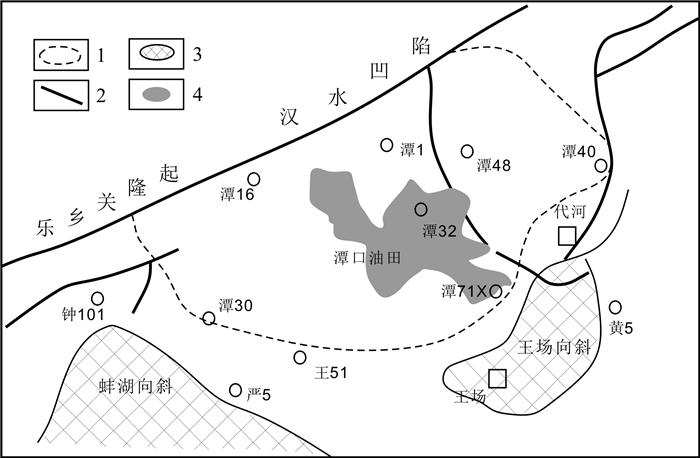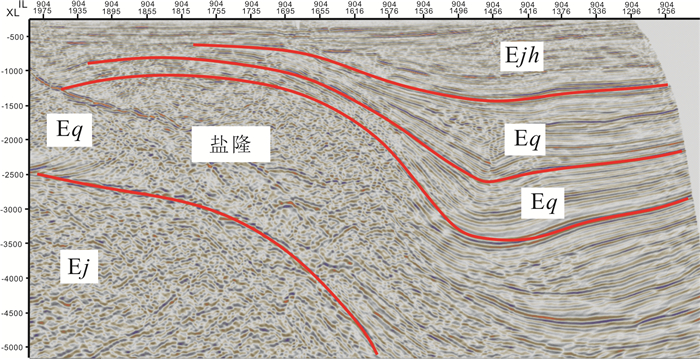DISCUSSION ON THE SALT STRUCTURE TYPES AND GENETIC MECHANISM OF QIANJIANG FORMATION IN QIANJIANG DEPRESSION, JIANGHAN BASIN
-
摘要:
潜江凹陷位于江汉盆地的中部,潭口油田靠近潜北大断层.通过勘探开发,根据测、钻井资料及生产动态数据发现,该区地层厚度在短距离内发生较大变化,砂体间的侧向连续性差,范围小.该地区盐岩十分发育,根据地震剖面以及盐层的发育,分析该地区产生一系列盐构造的类型,分别有盐层滑脱带以及滑脱断层、盐隆构造、盐辟构造等几种类型.该地区的盐构造的成因机制主要为走滑作用,根据盐构造的类型,成因机制可分为盐层滑脱作用、盐层隆升作用以及盐层刺穿作用.将盐构造的演化分为3个阶段,分别为荆沙组盐构造孕育期、潜江组潜四-潜三段盐构造生成期、潜江组潜二段-荆河镇组盐构造定型期.盐岩的发育以及盐构造的形成,在一定程度上导致目的层砂体侧向连续性差,油层展布范围小,对油气成藏产生影响.
Abstract:The Qianjiang Depression is located in the central part of Jianghan Basin with Tankou oilfield close to the Qianbei fault. Through exploration and exploitation, it is found that the formation thickness varies greatly in a short distance with poor lateral continuity and narrow distribution range between sand bodies according to the logging, drilling and production performance data. As the salt rocks are well developed in the area, the types of a series of salt structures including salt bed detachment zone, detachment fault, salt dome and salt diapir structures are analyzed based on the seismic section and development of salt bed. The genetic mechanism of salt structures in the area is dominated by strike-slip. According to the salt structure types, the genetic mechanism can be recognized as salt bed detachment, uplift and diapirism. The evolution of salt structure is divided into three stages:the incubation period of salt structure in Jingsha Formation, the formation period of salt structure in Eq4-Eq3 of Qianjiang Formation, and the finalization period of salt structure in Eq2-Jinghezhen Formation. The development of salt rocks and formation of salt structures lead to the poor lateral continuity of target sand body and small distribution range of oil layer, thus exerting an effect on the oil-gas accumulation.
-
Key words:
- Qianjiang Formation /
- salt structure /
- genetic mechanism /
- evolution of salt structure /
- Tankou area /
- Jianghan Basin
-

-
[1] 余一欣, 周心怀, 彭文绪, 等.盐构造研究进展述评[J].大地构造与成矿学, 2011, 35(2):169-182. doi: 10.3969/j.issn.1001-1552.2011.02.001
[2] 杨玉卿, 张永生, 漆智先, 等.盐湖沉积的韵律性及成盐韵律类型——以潜江凹陷潜江组古盐湖沉积为例[C]//2001年全国沉积学大会摘要论文集. 2001: 512.
[3] 吴娟, 叶加仁, 康建云, 等.潜江凹陷北部潜江组油气分布不均一性及控制因素[J].地质科技情报, 2012, 31(6):141-146. http://www.cnki.com.cn/Article/CJFDTotal-DZKQ201206023.htm
[4] 方志雄.潜江凹陷隐蔽油藏成藏主控因素及勘探方向[J].石油与天然气地质, 2006, 27(6):804-812. doi: 10.3321/j.issn:0253-9985.2006.06.011
[5] 张广英, 陈凤玲.潭口地区潜江组地层对比与油气勘探有利地带[J].江汉石油职工大学学报, 2007, 20(2):35-38. doi: 10.3969/j.issn.1009-301X.2007.02.009
[6] 王国力, 杨玉卿, 张永生, 等.江汉盆地潜江凹陷王场地区古近系潜江组沉积微相及其演变[J].古地理学报, 2004, 6(2):140-150. doi: 10.3969/j.issn.1671-1505.2004.02.002
[7] 费安国.钟潭地区高陡构造油藏提高开发效果技术探讨[J].江汉石油职工大学学报, 2017, 30(5):37-39. doi: 10.3969/j.issn.1009-301X.2017.05.012
[8] 詹冶萍, 杨香华, 潘知峰, 等.江汉盆地潜江凹陷潜三段古地貌与砂体成因分析[J].古地理学报, 2009, 11(4):405-412. http://www.wanfangdata.com.cn/details/detail.do?_type=perio&id=gdlxb200904005
[9] 方志雄, 陈开远, 杨香华, 等.潜江盐湖盆地层序地层特征[J].盐湖研究, 2003, 11(2):14-23. doi: 10.3969/j.issn.1008-858X.2003.02.003
[10] 张永生, 杨玉卿, 漆智先, 等.江汉盆地潜江凹陷古近系潜江组含盐岩系沉积特征与沉积环境[J].古地理学报, 2003, 5(1):29-34. doi: 10.3969/j.issn.1671-1505.2003.01.003
[11] 柏建新, 石万忠, 何勇.潜江凹陷潜北地区潜四下段盐湖层序控制因素及层序模式[J].中国石油勘探, 2014, 19(1):22-30. doi: 10.3969/j.issn.1672-7703.2014.01.003
[12] 高楠安.江汉盆地江陵凹陷盐构造类型及成因机制探讨[J].石油地质与工程, 2013, 27(2):9-11. doi: 10.3969/j.issn.1673-8217.2013.02.003
[13] 汤良杰, 黄太柱, 邱海峻, 等.塔里木盆地中央隆起带中、西段及邻区中、下寒武统盐相关构造及其变形机理[J].中国科学:地球科学, 2013, 43(1):33-43. http://www.wanfangdata.com.cn/details/detail.do?_type=perio&id=zgkx-cd201301003
[14] 崔永刚, 樊涛, 孙昶旭, 等.盐构造发育对沉积地层的影响——以东营凹陷中央隆起带郝现构造为例[J].新疆石油地质, 2006, 27(6):696-698. doi: 10.3969/j.issn.1001-3873.2006.06.013
[15] 李忠平.盐湖盆地相控砂体预测技术研究——以江汉盆地潜江凹陷为例[D].武汉: 中国地质大学, 2013.
[16] 康海霞.潜江凹陷潜江组剥蚀恢复与沉积体系研究[D].北京: 中国地质大学, 2009.
[17] 范传军.江汉盐湖盆地潜江组沉积控制因素与岩性油藏[J].江汉石油职工大学学报, 2006, 19(6):25-28. doi: 10.3969/j.issn.1009-301X.2006.06.007
[18] 汤良杰, 余一欣, 陈书平, 等.含油气盆地盐构造研究进展[J].地学前缘, 2005, 12(4):375-383. doi: 10.3321/j.issn:1005-2321.2005.04.006
[19] 戈红星, Jackson M P A.盐构造与油气圈闭及其综合利用[J].南京大学学报, 1996, 32(4):640-649. doi: 10.3321/j.issn:0469-5097.1996.04.001
[20] 杨长清.江陵凹陷盐构造及与油气聚集的关系[J].断块油气田, 2004, 11(3):4-6. doi: 10.3969/j.issn.1005-8907.2004.03.002
-




 下载:
下载:









